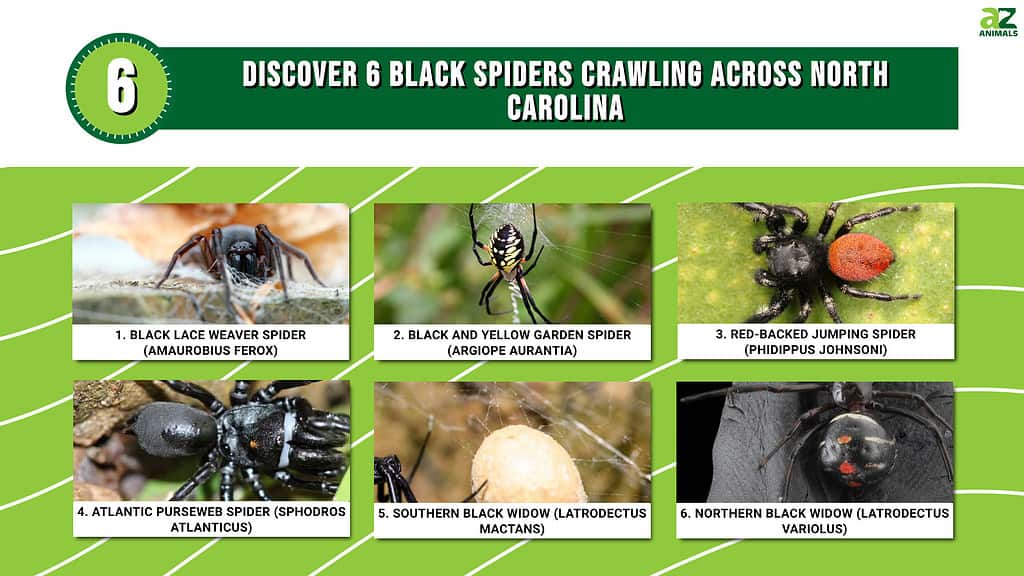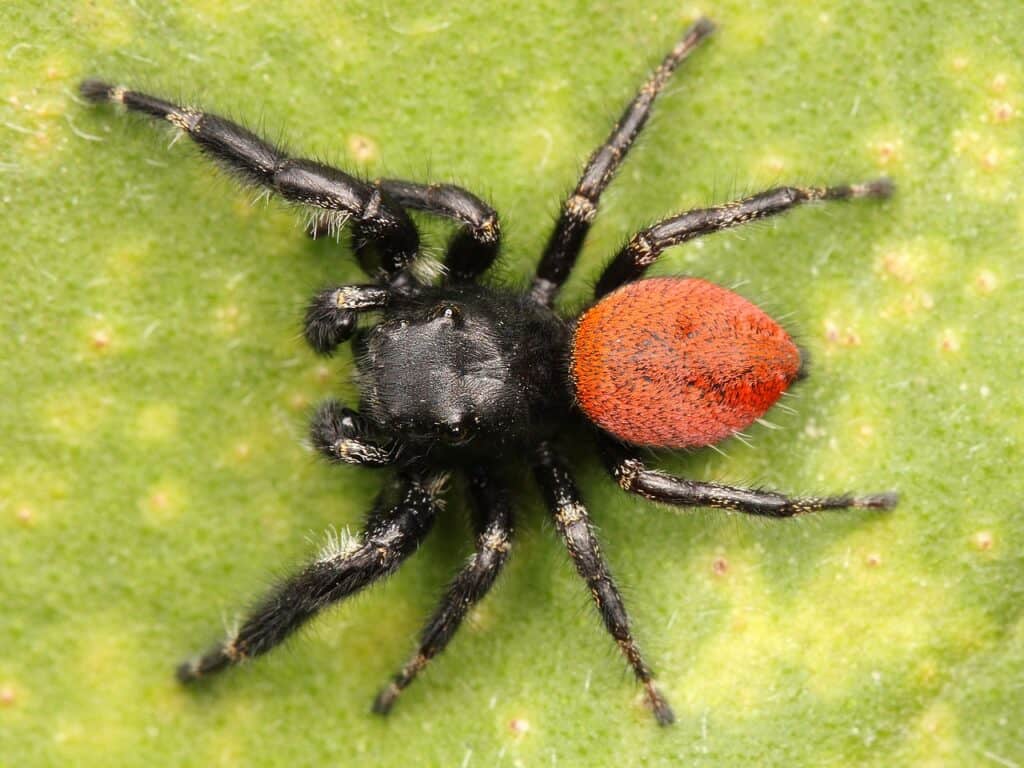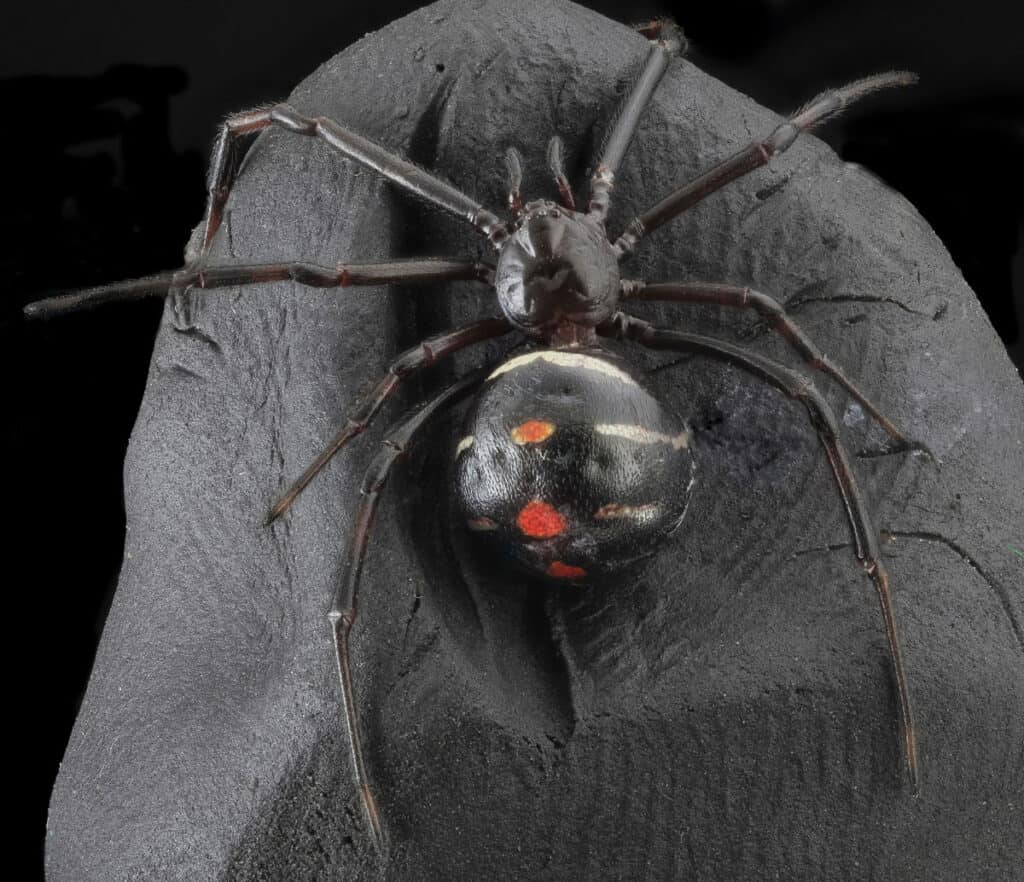
In the state of North Carolina, a creature with eight legs and a menacing reputation waits to strike. It’s the black spider, an arachnid that is both feared and admired for its striking appearance and (sometimes) painful bite.
These elusive spiders may be hard to spot, but their impact on the ecosystem is significant. In this article, we’ll delve into the mysterious world of North Carolina’s black spiders. Let’s discover what makes them one of the most intriguing creatures in the state’s wilderness.
1. Black Lace Weaver Spider (Amaurobius ferox)

These spiders build distinctive cribellate webs, which serve as a tool for capturing prey and providing a safe haven.
©Wildsmith_Westwood/Shutterstock.com
The black lace weaver spider, originally from Europe, has found a new home in the state of North Carolina.
The primary color of the black lace weaver’s body is black, making it a standout among other species. However, its abdomen features a unique marbled appearance with pale yellow-brown areas, which adds to its distinctive look. Both males and females share this appearance, although males are typically smaller and slimmer in comparison to their female counterparts. Black lace weavers measure between 0.19 to 0.59 inches in length.
These spiders build distinctive cribellate webs, which serve as a tool for capturing prey and providing a safe haven. The silk used to spin this web is unique in texture. It contains extremely thin and exceptionally sticky fibers that create a woolly appearance.
In North Carolina, this spider is commonly found in a variety of habitats, such as under stones, logs, and hedgerows. Their ability to seek shelter under rocks and logs allows them to hide from predators and capture prey more efficiently.
As skilled hunters, these spiders feed on a variety of small insects and arthropods, such as flies, beetles, and ants. Their sticky silk traps their prey, allowing them to immobilize and consume their meals quickly.
While the black lace weaver spider does possess venom, it is not known to be fatal to humans. However, their bite can still cause discomfort and pain that can last for several days. Although the black lace weaver spider is not generally aggressive towards humans, it may bite if provoked or threatened.
Fun Facts
- Black lace weaver spiders are primarily nocturnal and are most active during the nighttime hours.
- During the late summer and autumn months, males often venture out in search of potential mates.
- Spiderlings are known to exhibit cannibalistic behavior, consuming their own mother after hatching.
2. Black and Yellow Garden Spider (Argiope aurantia)

Symmetrical patches of bright yellow adorn the top side of the female’s abdomen.
©iStock.com/AwakenedEye
The Argiope aurantia spider is a striking sight commonly observed during the late summer months in North Carolina.
Symmetrical patches of bright yellow adorn the top side of the female’s abdomen. These contrast against a black background, hence this spider’s name. The legs of the female are reddish-brown near the base and gradually darken towards the tips. On the other hand, males exhibit a less striking appearance with smaller bodies, brownish legs, and fewer abdominal patches.
In terms of size, female spiders are significantly larger than males, measuring around ¾ to 1 inch in length (excluding legs). Males are only about ¼ inch long.
These spiders belong to the Araneidae family and are well-known for their distinctive, stereotypical spider webs. They use their webs to capture prey and are particularly skilled at catching insects in gardens. Once prey is trapped, the spider injects it with a venomous bite, which effectively paralyzes it.
Black and yellow garden spiders are often spotted weaving their webs in gardens and grassy regions close to residential areas. These spiders are also commonly found in tall grasslands.
Their diet primarily consists of grasshoppers and flying insects, although they are not selective in their prey. These spiders are highly beneficial to gardeners, as they frequently capture and consume a wide range of insects.
While they may look dangerous, the garden spiders are non-venomous and do not typically bite unless they feel threatened. In the event of a bite, the effects are minor, with some people reporting it feels like a bee sting.
Fun Facts
- Black and yellow garden spiders are solitary creatures and spend most of their adulthood alone.
- The lifespan of these spiders is around one year in temperate climates.
- Females tend to spend most of their time in their webs and do not frequently wander.
3. Red-Backed Jumping Spider (Phidippus johnsoni)

Both males and females have a brilliant, red-colored abdomen, but the female also features a central black stripe.
©Kaldari / CC0 via Wikimedia Commons – License
The red-backed jumping spider is widely distributed across the United States, including the state of North Carolina.
This jumping spider reaches a length of approximately 0.35 – 0.55 inches in adulthood. Males are on the smaller side. Both males and females have a brilliant, red-colored abdomen, but the female also features a central black stripe. The chelicerae, which are the spider’s mouthparts, have a distinct, shiny teal coloration in both sexes. Apart from that, the remaining body parts of the spider are primarily black in color.
These spiders primarily rely on their silk-spinning ability to create a safety line while jumping. This safety line acts as a contingency plan, allowing the spider to regain safety if the jump goes awry. In the event of a failed jump, the spider can use this line to climb back up to safety.
This spider typically lives in habitats that are dry, such as oak woodlands or coastal dunes.
The diet of the red-backed jumping spider consists of a wide range of insects, such as bugs, flies, and moths. Interestingly, this spider species has a significant preference for preying on other spiders.
When encountering humans or other animals, the red-backed jumping spider does not exhibit aggressive behavior. Instead, they try to avoid confrontation by running or jumping away from potential threats.
However, in rare cases, they may bite humans or pets. This could result in local swelling or, in severe cases, a mild headache.
Fun Facts
- Female red-backed jumping spiders exhibit cannibalistic behavior by consuming males after mating.
- Similar to other jumping spiders, they do not spin webs.
- These spiders usually prey on insects that are approximately half their size.
4. Atlantic Purseweb Spider (Sphodros atlanticus)

The Atlantic purseweb spider has a unique hunting strategy as it is an ambush predator.
©iStock.com/ArendTrent
Atlantic purseweb spiders are members of the Atypidae family, commonly referred to as purseweb spiders or atypical tarantulas.
The females have an average length of around one inch, while the males are noticeably smaller in size. They are predominantly black in color, with both the cephalothorax and abdomen appearing relatively similar in size.
One striking feature of this spider is its oversized chelicerae and elongated spinnerets, which are characteristic of their family.
The Atlantic purseweb spider has a unique hunting strategy as it is an ambush predator. These arachnids construct silken tubes along the ground or tree trunks where they conceal themselves. Once the unsuspecting prey ventures near the entrance of the tube, the spider pounces on it, swiftly dragging it inside for consumption.
The Atlantic purseweb spider resides in damp woodland habitats, although it also inhabits swamps or open woods. These spiders typically inhabit temperate to tropical climates, where they are able to thrive.
Similar to other spiders, the Atlantic purseweb spider primarily subsists on a diet comprising insects, small spiders, and similar-sized creatures.
As with most spider species, the Atlantic pursewebs possess venom, which they use to immobilize their prey. They are even capable of biting humans if provoked.
However, these bites are not harmful to humans, except in rare cases where individuals are exceptionally sensitive to spider bites. In such a case, they must seek medical attention immediately.
Fun Facts
- Female Atlantic purseweb spiders primarily live within their tubular webs and are rarely seen.
- They have a physique similar to wolf spiders, with a low stance and legs that extend outward.
- The two sexes mate, cohabitating until the male’s demise, after which the female consumes him.
5. Southern Black Widow (Latrodectus mactans)

Like most spiders, southern black widows produce a sturdy silk that they use to construct webs for ensnaring their prey.
©Jeff W. Jarrett/Shutterstock.com
The southern black widow spider, a venomous arachnid infamous for its toxicity, resides in North Carolina. This spider has a glossy, jet-black appearance and plump, round abdomen. The upper portion of its abdomen is uniformly black, while the underside bears a distinctive red hourglass marking.
Femals measure around 0.6 inches in length, while males are considerably smaller at just 0.23 inches.
Like most spiders, southern black widows produce a sturdy silk that they use to construct webs for ensnaring their prey. However, unlike other spider species, these widows randomly build their webs without any discernible pattern.
They inhabit various outdoor habitats, such as piles of wood or rocks, rodent burrows, and hollow tree stumps. They may also take up residence in indoor spaces such as garages, sheds, basements, and outhouses.
As carnivorous predators, these spiders feed on a range of flying and crawling insects, including flies, grasshoppers, and other spiders.
Southern black widow spiders are known for their highly toxic venom. Initial symptoms may include localized pain and skin irritation. However, in more severe cases, a condition called “latrodectism” can occur. The condition is characterized by systemic toxicity that can lead to widespread pain, muscle spasms, and dysfunction of the autonomic nervous system.
Fun Facts
- Southern black widows can be preyed upon by wasps, scorpions, and centipedes.
- The spider’s name stems from the myth that females kill and eat the male after mating.
- Females live for about 1.5 years, while males have a much shorter lifespan of two to five months.
6. Northern Black Widow (Latrodectus variolus)

Unlike the southern black widow, the northern black widow’s distinct hourglass pattern appears fragmented.
©Porco_Rosso/Shutterstock.com
The northern black widow spider sports a shiny black abdomen featuring sizeable red circles on its upper surface. Unlike the southern black widow, which displays a solid hourglass pattern, the northern black widow’s distinct hourglass pattern appears fragmented.
Although the northern black widow spider possesses a venomous bite, it generally displays a non-aggressive demeanor toward humans and does not actively attempt to attack them. Instead, this species of spider typically keeps to itself and tends to remain out of sight.
These spiders thrive in a variety of outdoor habitats, such as woodlands, piles of wood and stones, and secluded areas within sheds and garages.
The northern black widow is a ferocious hunter. It preys on live insects, arthropods, and spiders, including members of its own species. Despite their small size, they are capable of catching prey ranging from half the size of a house fly to large creatures such as cicadas and scorpions.
A bite results in severe pain, which intensifies over the course of several hours. In addition to pain, other symptoms may include fever, sweating, nausea, weakness, and rapid heart rate. Seeking medical attention can help manage the discomfort. Medical staff can closely monitor any further symptoms until the patient fully recovers.
Fun Facts
- A doctor’s visit is recommended for any individual who has been bitten by a northern black widow.
- Northern black widow sightings are rare, as the species is primarily only active at night.
- Only female northern black widow spiders are dangerous, while males are harmless.
The photo featured at the top of this post is © Ernie Cooper/Shutterstock.com
Thank you for reading! Have some feedback for us? Contact the AZ Animals editorial team.






